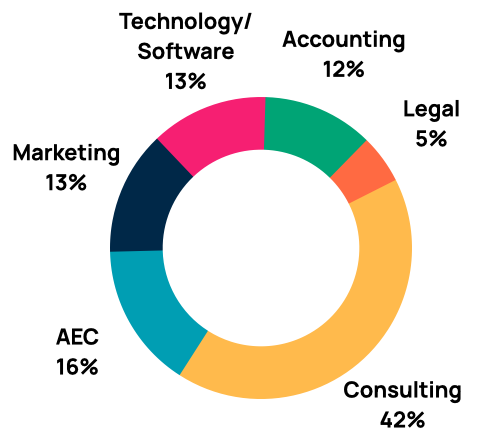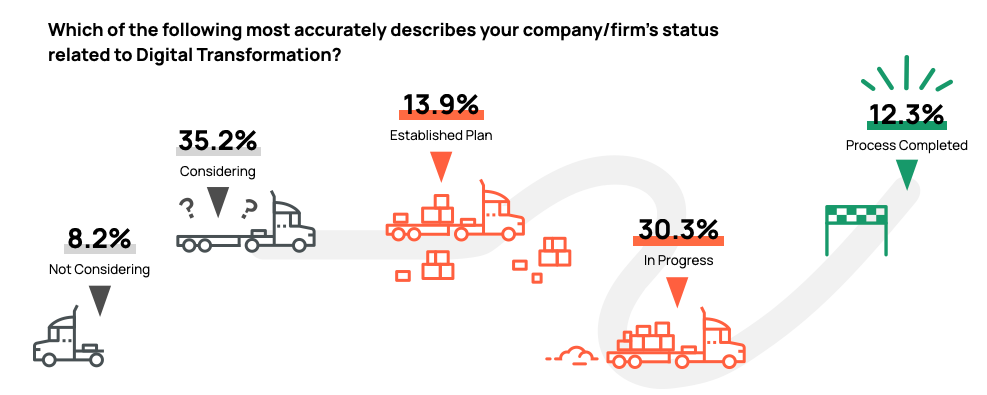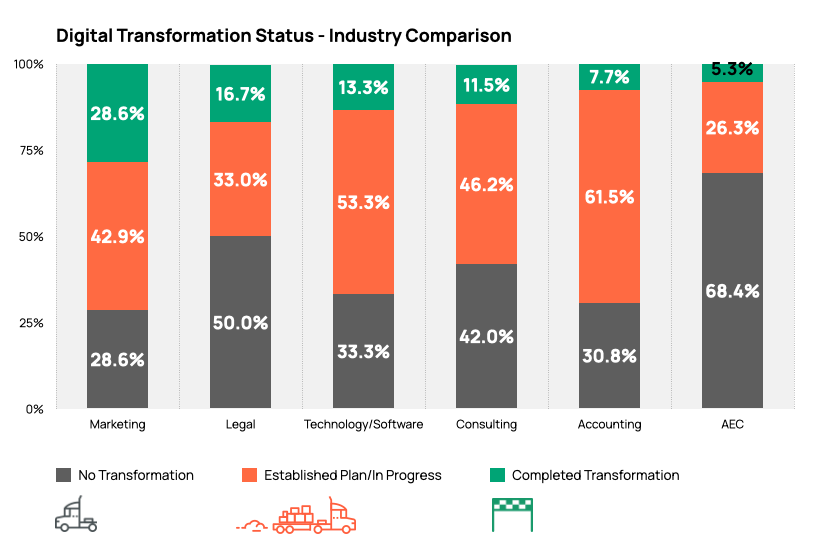The coronavirus pandemic accelerated the need for remote teams, location-independent business operations – and all of the digital transformations required to make these possible. In a blink of an eye, professional services firms went from casual Fridays at the office to virtual happy hours at home on Zoom; and now, most professionals are wondering if the “office” has become an obsolete relic of the 20th-century.
The most agile firms responded to pandemic-related challenges by transforming their operations with advanced digital technologies that empowered them to survive – and thrive – in the new business reality. But even under the most tremendous pressures to change, the vast majority of professional services firms are still evaluating how to implement their digital transformation agendas while struggling to answer fundamental questions about the process.
The most common questions decision-makers ask about digital transformation include:
- How does my firm’s “digital maturity” compare to others?
- What are the most common digital transformation goals?
- What percentage of firms have completed digital transformation?
- Which industries are first in digital transformation and which ones are lagging behind?
- What are the benefits of digital transformation?
- What helps and hinders digital transformation success?
To investigate the answers to these questions, Hinge surveyed scores of business executives from six core professional services industries to create The Digital Transformation Imperative: a research report that addresses all of the above questions and more while exploring the pivotal trends impacting digital transformation now.
About the Study Sample
The Digital Transformation Imperative features research from a sample of 136 business executives and decision-makers. All participants worked in one of six core professional services industries with the following distribution:
- Technology/Software (13%)
- Accounting (12%)
- Marketing (13%)
- AEC (16%)
- Consulting (42%)
- Legal (5%)

All participants held decision-maker roles in their industries with the following distribution of roles:
- Chief Executive Officer (29%)
- CMO/VP of Marketing (26%)
- Director/VP/Manager of Digital Products (18%)
- Chief Product/Technology Officer (9%)
- Consultant (8%)
- Owner/Founder (7%)
- Director/VP/Manager of E-Commerce (4%)

What Is Digital Transformation?
Before discussing the key findings in The Digital Transformation Imperative, it’s important to define the term digital transformation in the context of this study:
“Digital transformation refers to the process of leveraging advanced digital technologies to create new – or vastly improved – business processes, organizational cultures, and customer experiences to meet changing business and market requirements.”
Key Findings
The Hinge Digital Transformation Imperative explores the following key findings and more:
1. ONLY 12% OF PROFESSIONAL SERVICES FIRMS HAVE COMPLETED A DIGITAL TRANSFORMATION.
The data from survey participants indicated only 12% of firms had completed a digital transformation, and 57% of firms have not started any kind of digital transformation. Meanwhile, approximately one-third of firms are considering digital transformation, 14% have an established plan, and 30% are in progress.

The smallest percentage of firms (8%) were not considering digital transformation at all.
2. THE VAST MAJORITY OF FIRMS THAT UNDERGO DIGITAL TRANSFORMATION REALIZE POWERFUL ROI BENEFITS.
The vast majority of surveyed executives – from all six professional services industries in the study – agreed that undergoing a digital transformation brought substantial ROI benefits to their firms. On the whole, digital transformation improved all key performance indicators relating to operational efficiency, profitability, revenue, brand awareness, and client satisfaction.
Operational efficiency saw the greatest improvement with an average increase of 76%. Client satisfaction saw average improvements of 70%, and profitability saw average improvements of 61%.
A negligibly small number of firms reported any net loss pertaining to failed digital transformation endeavors. Where those losses were reported, they were also exceedingly small.
3. 70% OF FIRMS FEEL THAT THEY ARE LAGGING BEHIND WHEN IT COMES TO DIGITAL TRANSFORMATION.
One of the most shocking findings in the report is that over 70% of surveyed executives rated the level of digital maturity at their firms as “low.” Likewise, when viewing each of the core professional services industries separately, on average, each sector rated itself as having “low digital maturity.” Even technology/software companies assessed themselves, on average, as having a low level of digital maturity.
The survey defined “low” digital maturity as follows:
- Processes are immature, data is inconsistent, and paper and spreadsheet usage are prevalent.
- Company reacts to circumstances as they emerge and projects are often carried out manually.
- Organized data is categorized and stored in a centralized repository and organized so it is easily accessible when needed.
Only 8% of respondents felt that their companies had achieved a “high” level of digital maturity.
Download The Digital Transformation Imperative: A Research Report for Professional Services Firms
4. THE PRIMARY GOAL OF MOST DIGITAL TRANSFORMATIONS WAS TO IMPROVE CUSTOMER/CLIENT EXPERIENCES.
Using digital technologies to improve customer/client experience is the most common goal driving digital transformations in the professional services industries. Another common driver of digital transformation is the desire to improve team member efficiency through the ability of digital technologies to automate costly and tedious tasks that monopolize the time of team members.
5. AEC FIRMS ARE THE LEAST LIKELY TO HAVE COMPLETED A DIGITAL TRANSFORMATION.
As the table below indicates, AEC firms trail all other professional services industries when it comes to digital transformation. In fact, 68.4% of AEC firms have not completed a digital transformation. In contrast, marketing firms were the most likely to have completed a digital transformation – with 70% of claiming that they have either completed a digital transformation or have a plan in place.
The table further shows that within the accounting industry few firms (7.7%) have completed a digital transformation. Nevertheless, the accounting industry is leading the field in terms of active digital transformation plans in progress – with 61.5% of firms moving forward with digital transformation strategies at this time.

6. HIRING A THIRD-PARTY SERVICE PROVIDER INCREASES THE CHANCES OF DIGITAL TRANSFORMATION SUCCESS.
Nearly half of firms that have not conducted or started the process of digital transformation cite lack of knowledgeable/experienced staff as a significant obstacle. Surveyed respondents often reported that their firms lacked the talent that a digital transformation requires. “The Great Resignation” has made it even more difficult to find seasoned digital transformation talent. For these reasons, hiring third-party expertise to manage the digital transformation process makes the most sense.
According to the survey, companies that leveraged third-party digital transformation experts achieved greater success than those that tried to manage the process on their own. While it’s true that third-party vendors come with higher price tags, they also come with much higher rates of success. These vendors can reduce operational burdens, labor costs, and the risk of hiring and training new staff.
Download The Digital Transformation Imperative: A Research Report for Professional Services Firms
A Final Thought
According to The Digital Transformation Imperative, professional services firms that carry out digital transformations achieve clear and dramatic ROI benefits – including increased operational efficiency, better customer experiences, and a greater ability to support remote teams during pandemic conditions.
That being said, a surprising number of professional firms have yet to plan or complete the most basic steps and investigations surrounding digital transformation, even in the face of increasing coronavirus and business-related pressures.
For the time being, the slowness of professional services firms to leverage digital transformation strategies has created a brief window of opportunity for the earliest adopters of these transformative technologies to gain a tremendous advantage over their less savvy competitors.
Related: What Every Executive Should Know To Grow Their Brand


